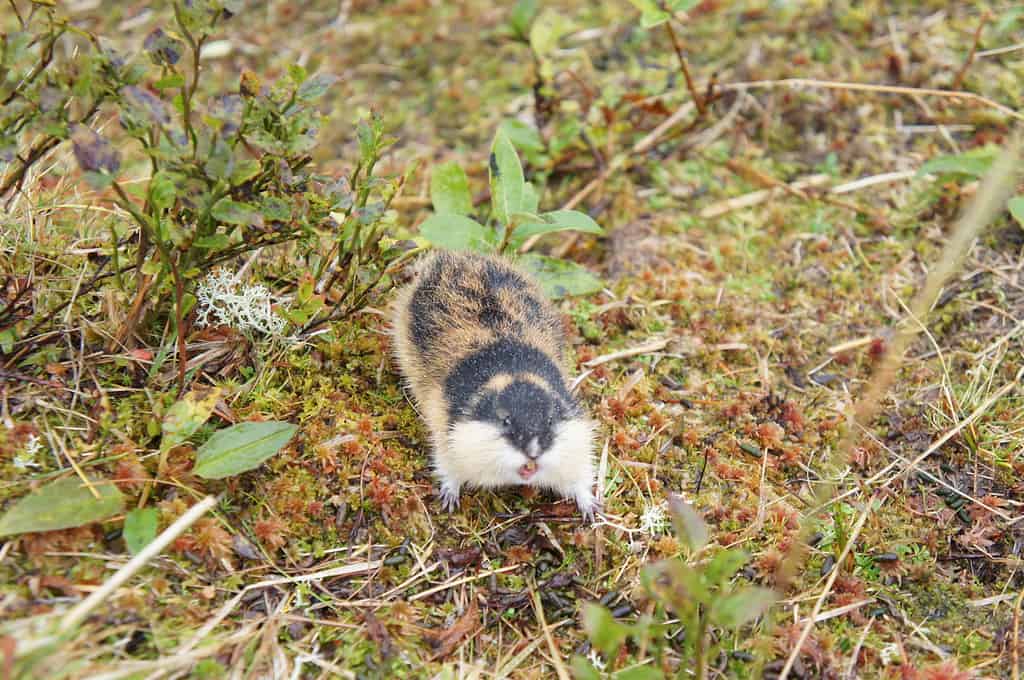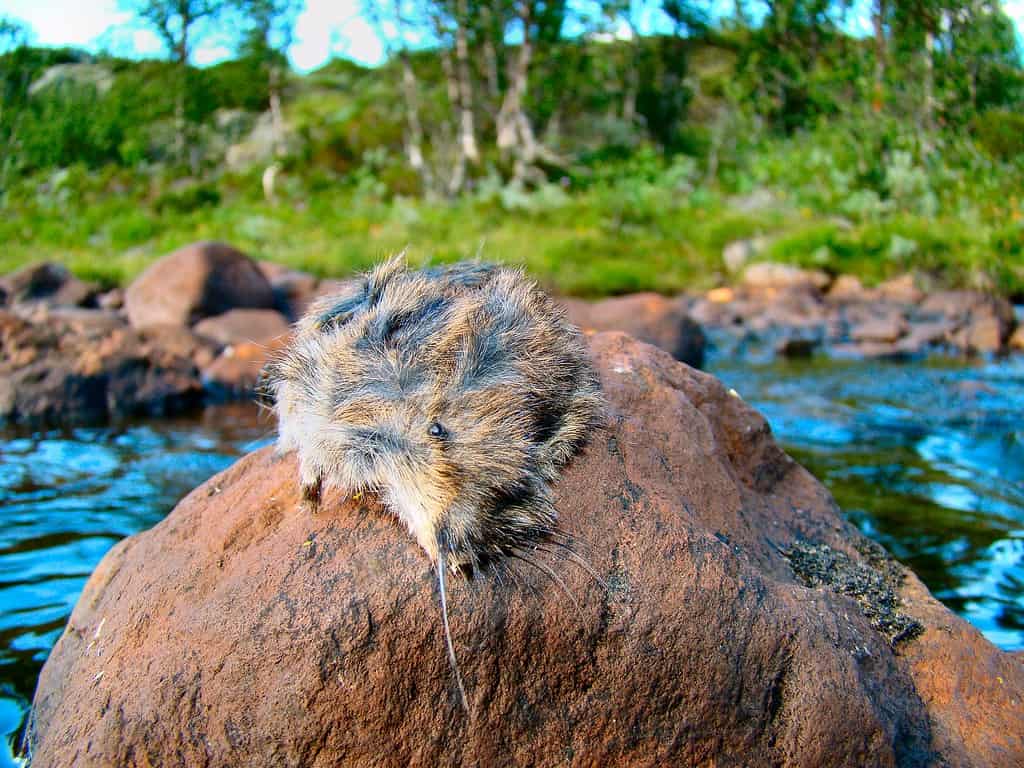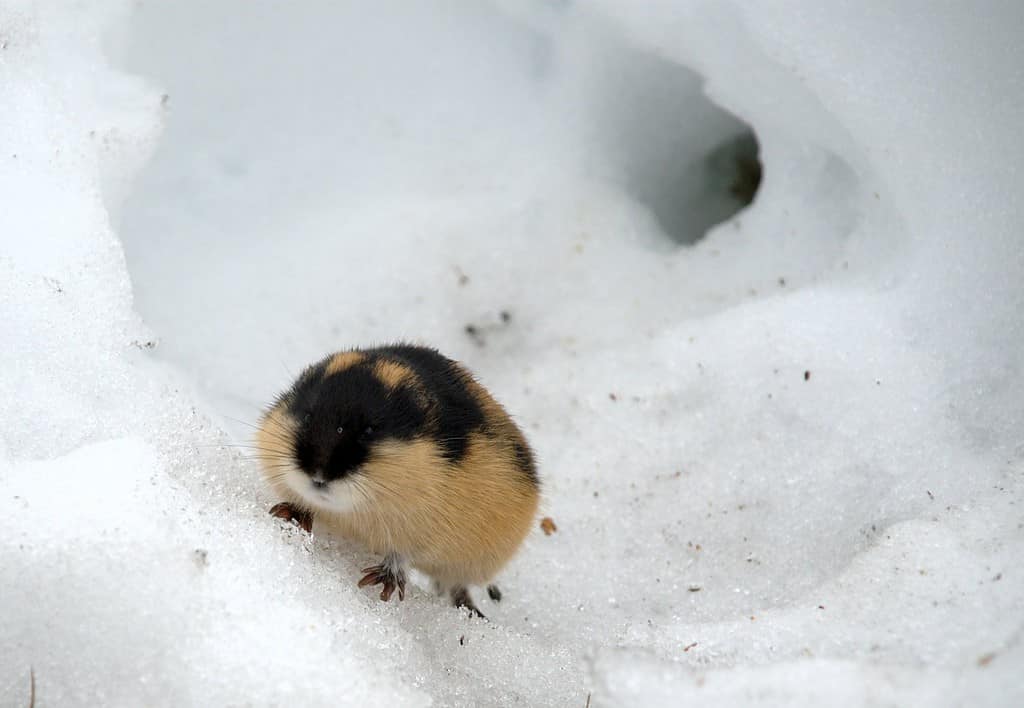Lemmings are known as the animals who commit mass suicide by walking off cliffs into the sea. There is also a rumor that the rodents explode when they become severely angry. How much truth is there to these strange and disturbing myths? Let’s find out if lemmings commit mass suicide and discuss some other interesting facts about these small, bizarre rodents.
An Overview of Lemmings

Lemmings can be ferocious when they feel threatened or deem their home, food, or babies threatened.
©Andreaze / CC BY-SA 3.0 – License
Lemmings are small rodents, like hamsters, who live in or near the Arctic Circle and inhabit tundra biomes, sphagnum bogs, coniferous forests, treeless alpine, and semidesert regions. They construct long, branching tunnels under rocks and vegetation. Some species also make tunnels underneath the snow on the tundra, which provides safety and food for the lemmings during cold seasons. The small creatures feast on grass, roots, buds, leaves, twigs, and vegetation.
Regarding appearance, lemmings are small, stocky rodents with short tails and legs. They have small ears that lie flat against their heads. The smallest species of lemming measure 3.1 – 4.7 inches and weigh a minute 0.7 – 1.0 ounces. The other species of lemmings measures 3.94 – 8.66 inches and weighs 1.06 – 3.95 ounces. Lemmings vary somewhat in color depending on where they are native. The collared lemming is grey with reddish-brown and black stripes on their faces and backs. In winter, they are white or light grey. Other species of lemmings are yellowish-tan, grey, brown, or black.
Suicide Awareness for Lemmings?

Lemming migration can result in death.
©Popular Science Monthly Volume 11 / Public domain – License
It’s tough being a lemming, especially when the human population seems to scrutinize your every life choice. Let’s get to the bottom of the infamous myth: do lemming commit mass suicide by jumping off cliffs? The answer is, “It’s complicated.” The small, compact, and rather cute rodents don’t exactly mean to end their lives; it happens sometimes.
The lemming population has become so large that some occasionally migrate to other areas. They do this for several reasons. One is because lemmings aren’t really big fans of socializing, and when their population becomes crowded, they are forced to have unfortunate interactions with each other. Another big reason is that there isn’t enough vegetation or space for burrows. This isn’t a yearly event. Typically, it takes a few years before their numbers become so massive that something must be done. Also, with more lemmings attracting predators, none are safe. The lemming population only becomes unmanageably large when everything works out too well. Without many predators and plenty of food and near-perfect reproducing opportunities, the numbers can grow quickly, like with most species of rodents. Lemmings live for one to three years and reproduce quickly in that short time.
Huge Crowds Are Dangerous, Even For Lemmings
Many lemmings will join small groups at night to presumably brave the dark world for a new life during migrations. They aren’t in huge groups at that point and might even find a nice new home that isn’t quite so crowded close by. On the other hand, these territorial rodents only live on average one year but can live to see three if they’re lucky, so time isn’t on their side. In Norway, the lemmings sometimes migrate in huge numbers during the day. If they come upon a cliff, road, or waterway, the momentum caused by the pushing lemmings piling up behind those in the front will push them in, and they will typically die. They don’t do this intentionally; they are all just desperate to find safety. If you’ve ever been in a massive crowd when it is pushing forward, you probably know how dangerous it can be.
So many lemmings end up drowning, falling, being caught by predators, run over by cars, or trampled to death by other lemmings. Many die in the expedition but also find new homes to establish with plenty of space and vegetation for everyone.
Do Lemmings Explode If They Become Extremely Angry?

Not all of the migrating lemmings make it. Falling into water is typically a death sentence for the brave rodents.
©Bjørn Christian Tørrissen / CC BY-SA 4.0 – License
No, lemmings do not explode when they become angry. They can be extremely vicious and territorial when their space is threatened. The lemmings will even go so far as to attack other animals who come into their territory or make them angry in some other way. They can become, figuratively speaking, “explosively angry,” but they do not explode.
This one is a bit amusing in a sick and twisted way. In 1991, a puzzle-building and strategy game called Lemmings emerged for numerous systems. In the game, lemmings would explode occasionally when the time ran out. You can see where this myth most likely began in the video below.
A Few More Interesting Facts About Lemmings

A cute collard lemming can have many colors of its fur before becoming white in the winter.
©kgleditsch / CC BY-SA 2.0 – License
- The 1958 Disney Documentary White Wilderness (see video clip below) was why everyone believed the lemmings to commit mass suicide. It was nothing more than staged camera tricks. Lemmings do not jump off cliffs on purpose. The entire reason they migrate is to start a new life somewhere better.
- Lemmings do not hibernate.
- The wood lemming gives birth to three times more female offspring than males.
- Voles and muskrats are the closest rodent relatives to lemmings.
- Lemmings have long claws on their forefeet for digging and very strong teeth for gnawing on branches and roots. In the winter, collared lemmings grow longer and stronger claws on their third and fourth forefeet digits to help tunnel through icy snow. They are a bit like snow shovels.
- Norwegian or collared lemmings are brightly colored because they do not run from predators. The little ferocious rodents stand their ground. Maybe they are descendants of Viking lemmings?
- A lemming’s main defense tactic is to scream. They have a very loud, shrill warning cry to warn others of predators and scare the predator.
- The extremely thick and soft fur of a lemming is also waterproof. This comes in handy for those who burrow beneath the snow.
- A lemming’s burrow has room for every need. They have a room for sleeping, one for food storage, one for raising their young, and one for watching TV.
- Lemming fever or tularemia can also affect humans through bites or touching a contaminated animal.
The photo featured at the top of this post is © AGAMI stock/iStock via Getty Images
Thank you for reading! Have some feedback for us? Contact the AZ Animals editorial team.






